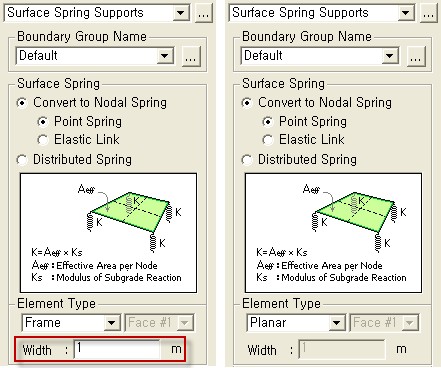[BOUNDARY] How to input surface spring coefficient for underground structure?
Surface Spring Supports function of midas Civil is a feature to enter the Soil boundary conditions
that is automatically calculated based on the area section shared. You can automatically enter a number of
boundary conditions representing the ground at once.
Ground structure are those which rests on the ground. The structure may sink depending on the size and shape of the
ground support and the load applied. Therefore, the boundary conditions of the soil must be in the form of spring having a stiffness rather than full constraints (Supports).
Midas Civil has boundary conditions, in form of spring stiffness, namely Elastic Link and Point Spring Supports
each with six degrees of freedom. Point Spring Support is a boundary condition to be entered at a node,
and Elastic Link is a boundary condition for entering between two nodes. Therefore, Point Spring Supports and Elastic Link
has to consider the allotment area for each node to give the spring coefficients in the boundary condition.
Ground Spring Coefficient = Section Area × Ground Reaction Force Coefficient
In the figure below, on left, shows a three-dimensional shape with three nodes, and on the right is the plan of the figure, the bottom of the tank.

For the boundary conditions to represent the soil type at the bottom surface of the water tank, you must enter a value at
node 17 to input the spring coefficient corresponding to the area 1m2. Similarly at node 20 and 5,
spring coefficient corresponding to the area 0.5m2 and 0.25m2 respectively, has to be entered.
If the geotechnical boundary conditions are to be entered only for a small number of nodes, you can enter as above,
taking into account the contribution of each sectional area. However, if the nodes you need to enter
the geotechnical boundary conditions are multiple in number, it can become a very cumbersome task.
Surface Spring Supports function of midas Civil is a feature to enter the soil boundary conditions which automatically
calculates spring coefficient based on the shared sectional area. By this way you can automatically enter a number of
boundary conditions of the ground at once.
Surface Spring Supports feature is available both for the line-element model and plate / three-dimensional elements model.
For Plate elements / three-dimensional element mode, the shared area of the selected nodes are automatically
considered in the spring coefficient calculation, and for the line element it is calculated by considering the Shared length × Width entered.

Therefore, the user to enter the geotechnical boundary conditions in the model, must be using the Surface Spring Supports.
And provide width of the ground reaction force coefficient for line elements.
that is automatically calculated based on the area section shared. You can automatically enter a number of
boundary conditions representing the ground at once.
Ground structure are those which rests on the ground. The structure may sink depending on the size and shape of the
ground support and the load applied. Therefore, the boundary conditions of the soil must be in the form of spring having a stiffness rather than full constraints (Supports).
Midas Civil has boundary conditions, in form of spring stiffness, namely Elastic Link and Point Spring Supports
each with six degrees of freedom. Point Spring Support is a boundary condition to be entered at a node,
and Elastic Link is a boundary condition for entering between two nodes. Therefore, Point Spring Supports and Elastic Link
has to consider the allotment area for each node to give the spring coefficients in the boundary condition.
Ground Spring Coefficient = Section Area × Ground Reaction Force Coefficient
In the figure below, on left, shows a three-dimensional shape with three nodes, and on the right is the plan of the figure, the bottom of the tank.
For the boundary conditions to represent the soil type at the bottom surface of the water tank, you must enter a value at
node 17 to input the spring coefficient corresponding to the area 1m2. Similarly at node 20 and 5,
spring coefficient corresponding to the area 0.5m2 and 0.25m2 respectively, has to be entered.
If the geotechnical boundary conditions are to be entered only for a small number of nodes, you can enter as above,
taking into account the contribution of each sectional area. However, if the nodes you need to enter
the geotechnical boundary conditions are multiple in number, it can become a very cumbersome task.
Surface Spring Supports function of midas Civil is a feature to enter the soil boundary conditions which automatically
calculates spring coefficient based on the shared sectional area. By this way you can automatically enter a number of
boundary conditions of the ground at once.
Surface Spring Supports feature is available both for the line-element model and plate / three-dimensional elements model.
For Plate elements / three-dimensional element mode, the shared area of the selected nodes are automatically
considered in the spring coefficient calculation, and for the line element it is calculated by considering the Shared length × Width entered.
Therefore, the user to enter the geotechnical boundary conditions in the model, must be using the Surface Spring Supports.
And provide width of the ground reaction force coefficient for line elements.
| Files | ||
|---|---|---|

|
||

|
||
|
|

